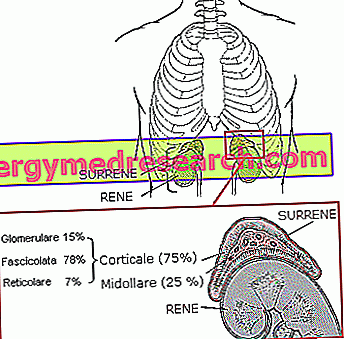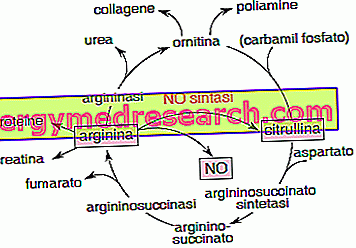Despite their small size, the adrenal glands are very important glands for our health. Their job, in fact, is to secrete different hormones, capable of influencing the activity of the whole organism.
Besides the hormones, whose activity is mainly under pituitary control, the adrenal processes the enzymes necessary for the synthesis of the same and their transformation. All steroid hormones, in fact, originate from a common precursor: cholesterol, which is then enzymatically transformed into glucocorticoids, mineralocorticoids and sex-active hormones. The metabolic pathways leading to the synthesis of these hormones are the same in the adrenal cortex, gonads and placenta, what changes is only the concentration of the various enzymes; the one assigned to the synthesis of aldosterone, for example, is expressed only in the glomerular region of the cortical portion of the adrenal gland.
 |
They consist of a specialized neuroendocrine tissue, closely related to the sympathetic nervous system. | ||||||||||
Their shape, although very variable, has been compared to that of a cone with a lower base or a Phrygian cap (conical hat, with the tip folded forward). Richly vascularized, they receive blood from the superior, middle and inferior adrenal arteries that derive, respectively, from the freni artery, from the aorta and from the renal artery. The venous return is ensured by the adrenal vein, which opens to the left in the renal vein and to the right in the inferior vena cava. | |||||||||||
Adrenal functions
Each adrenal gland consists of two portions, one internal, the medullary, and one external, the cortical . The two regions have very dissimilar embryological origins and anatomical, histological and functional peculiarities:
- the medullary portion of the adrenal gland constitutes about ¼ of the total mass of the gland, is softer, occupies the internal region and is responsible for the release of particular hormones, called catecholamines.
- The cortical portion envelops the medulla, covers the remaining ¾ of the glandular mass, is more consistent and secretes several steroid hormones. This region, also known as adrenal cortex or adrenal cortex, is in turn made up of three distinct portions by structure and function: the reticular zone, the fasciculata zone and the glomerular zone.
Adrenal hormones, cortical portion
The external glomerular area secretes aldosterone, a mineralocorticoid very important for the control of blood pressure. The aldosterone acts by increasing the reabsorption of sodium in the renal tubules and the excretion, again via the kidneys, of potassium. Further information in the dedicated article: aldosterone.
The intermediate collated zone produces glucocorticoids, so called because they are able to increase the plasma glucose concentration. The best known are cortisol and corticosterone, both synthesized by the adrenal gland in response to the pituitary hormone ACTH. These hormones are active in increasing glycaemia, glucose synthesis (gluconeogenesis) and glycogen synthesis (glycogenosynthesis), mobilization of reserve triglycerides and the use of muscle amino acids for energy purposes. To learn more: cortisol.
The deep reticular zone secretes mainly androgens (androstenedione), sex hormones typical of the male. Physiologically, they are of little importance in the male organism, because they are secreted in small quantities compared to what occurs at testicular level. In women, however, they help regulate sexual desire, sebaceous secretion and the development of pubic and axillary hair. These hormones give unmistakable signs of their presence when the adrenal gland goes mad, for example due to a tumor or an enzyme deficiency, and starts to produce them in excess. The endocrine disorder thus created determines, in women, hirsutism, breast atrophy, clitoral hypertrophy, etc. Further information in the dedicated article: androgens.
When the adrenal gland does not produce a sufficient proportion of corticosteroid hormones, a pathology known as Addison's disease takes over, often on an autoimmune basis, which is treated with the administration of artificial hormones similar to their natural counterpart.
Adrenal hormones, medullary portion
 | |
The medullary portion of the adrenal gland produces two important hormones, adrenaline and noradrenaline, which can be grouped together under the single term "catecholamine".
The medullary region develops from the same embryonic tissue as sympathetic neurons and is considered a neuroendocrine structure. Its function, in fact, is controlled by the central nervous system, which to communicate with it does not rely on hormones but on nerve impulses. This control mechanism allows the rapid release of catecholamines at the time of need, for example when you are faced with a sudden danger, to be faced as soon as possible.
After being released into the blood, the adrenal catecholamines prepare the body for the required effort: they increase the arterial pressure, dilate the bronchial tubes, accelerate the heart rate, stimulate the degradation of glycogen, increase glycaemia, accelerate respiratory actions and inhibit intestinal peristalsis . Further information on catecholamines produced by the adrenal gland in the dedicated article.



